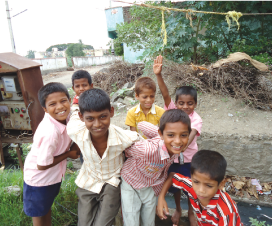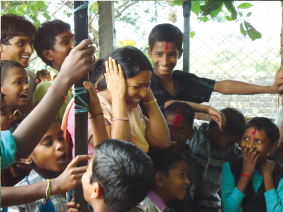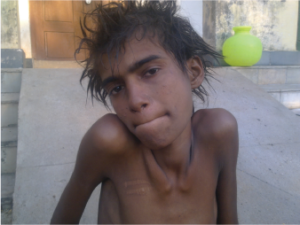In this interview, we listen to a pioneer in the ministry among street children, who sought a meaningful religious life, learnt much from the youth he served on the streets, and developed a new form of research based on direct action for change. Meet Fr. George Kollashany SDB, unconventional youth minister and life-long learner
1. FR GEORGE, YOU ARE KNOWN AS ONE OF THE PIONEERS OF THE MINISTRY AMONG STREET CHILDREN. HOW DID YOU GET INTO THIS MINISTRY?
The original inspiration is linked to my own vocation, and is associated with the social and ideological ferment of the early seventies. We, young religious, had questioned the ministry of Salesians (and of priests) then, who according to us were largely enjoying institutional positions. Caught up in this debate, some left; one joined Mother Theresa’s; one is now with the ‘Little Brothers.’ In response to my own questioning, I was sent to the Salesian presence in Vysarpadi (a very poor area of Chennai). Part of that complex was a centre for leprosy patients. I suppose the superiors wanted me to see and be impressed by our work with such poor persons. Yet, I was not impressed; for I considered it an exception and a one-man initiative.
However, the inspiration of the gospel on my sixteenth birthday was momentous for me. It was from the Gospel of Luke, chapter 4, verses 16-19: “The Spirit of the Lord is on me, because he has anointed me to proclaim good news to the poor. He has sent me to proclaim freedom for the prisoners and recovery of sight for the blind, to set the oppressed free, to proclaim the year of the Lord’s favour.” This, combined with the stories of early life of Don Bosco, made me continue to stay on with the Salesians.
Thanks to Fr. Varghese Menacherry SDB, who started the Sneha Bhavan in Kochi for the homeless, I began to look at Salesian life and my vocation differently. In fact we debated such issues in our formation house in Yercaud.
I started this mission way back in 1975, by making a deliberate commitment as a young Salesian. In my subsequent search and involvement and discussions as a youngster, I was able to evolve a new design for such an apostolate. We did this together with some friends during our theology studies in the early 1980s. In 1983, I wrote to the Provincial Council, asking that I I be assigned to work on the streets of Bangalore.
The same original inspiration has recurred in very providential ways to sustain my vocation. In fact, I had always felt that I was not sent to start some kind of “new work.” It became slowly evident that I was linked to the renewal or going back to the roots of the Salesian vocation. I saw that what I had to do was nothing exceptional or special; I just went with the flow. I never saw myself as a “pioneer,” for we were always a team. The image may have come out of the fact that I happened to be there at the right time and over a long period of time, consistently. May be my own limitations have perhaps hampered that progress and renewal of this ministry.
2. ANY TOUCHING EXPERIENCES YOU LIKE TO SHARE?
Here is one.
About two months ago, a young IT professional tracked me on Facebook and put me in touch with his father (Kumar), with whom I had lost contact for twenty-five years. Kumar had run away from his relatives who had murdered his father and mother and had changed his name and painstakingly concealed all details of his family and his story for almost eight years and had disappeared from my life, when I came to know some of the truths.
There are many stories of run-away youngsters returning home. The reunions are heart-wrenching. One child (Prasanth) returned home after ten years—only to discover that his place among the siblings had been taken over by a stranger. He was told by his own family that “the lost son had already returned much earlier” and is now the breadwinner and married and the rightful inheritor.
The young Prasanth persisted long enough for the mother to respond to her vibes to test both of them, asking both to show the scar on the thigh, which had been for her the birthmark of identification. Prasanth proved his identity, for he alone had that scar.
What to do now? Whom to accept into the family? Soon a solution was reached: The mother pronounced this judgement: Both are her children: one lost till now, but found, and the other by having grown in the place of the absent child.
3. YOU HAVE ALSO BEEN INVOLVED IN A TYPE OF RESEARCH CALLED ACTION-RESEARCH. WHAT IS IT? WHAT IS ITS RELEVANCE?
Yes, it had its origins when we were students in the eighties, when five of us formed a group that used to meet every Tuesday to discuss the “praxis” of what we were learning as students of theology. We wanted to understand better our experiences and challenges, as well as what the youngsters faced, so as detect the undercurrents and deeper causes.
After twelve years on the streets of Bangalore, I was asked to go abroad for studies. I chose to do my studies in India. It was also to help upcoming “start-ups’ and organisations to learn from their experiences on the street and thus to evolve strategies, by coming together regularly—at least once a month—and reflecting on their experiences. We called it the “Street Educators Training Program thorough Action Research.” In the following year (1994), the same program was taken up by Amsterdam University as a model and was globally implemented for three years as “Participatory Action Research” (PAR).
 The relevance of this approach is that it sustains quality of service and ensures that the leaders of the program as constantly growing and changing as required. Two of the projects that joined PAR—Navajeevan of Viajaywada and Sathi of Bangalore—have gone on to win national awards as the best NGOs working for children for the respective years. One project (Buddivantha of BOSCO, researched by Ms Mallika) was taken up by UNESCO, Geneva, as a path-breaking educational model. Three of the “peer leaders” (those who were once child labourers or “street” children) have gone on to become committed activists working for others in similar situations. One of them (Mr. Anandraj, who shared his stories as a child-labourer), is the founder of Margadharsi of Gulbarga, which has won the Karnataka Government award for the best NGO in the state for the year 2016.
The relevance of this approach is that it sustains quality of service and ensures that the leaders of the program as constantly growing and changing as required. Two of the projects that joined PAR—Navajeevan of Viajaywada and Sathi of Bangalore—have gone on to win national awards as the best NGOs working for children for the respective years. One project (Buddivantha of BOSCO, researched by Ms Mallika) was taken up by UNESCO, Geneva, as a path-breaking educational model. Three of the “peer leaders” (those who were once child labourers or “street” children) have gone on to become committed activists working for others in similar situations. One of them (Mr. Anandraj, who shared his stories as a child-labourer), is the founder of Margadharsi of Gulbarga, which has won the Karnataka Government award for the best NGO in the state for the year 2016.
Now, I am in the struggle of converting the same concepts and experiences into an institutional sharing and as communities: Integral Design of Experience And Learning (titled db-IDEAL).
4. HOW DO YOU COMBINE DIRECT MINISTRY AMONG THE DESTITUTE, AND RESEARCH?
I think the examples I have just given can answer that question. In fact, I would say that doing ministry without learning—without being challenged by struggles and problems to change ourselves and to shift our paradigms—is no ministry at all. Working on the periphery, especially with the young risk-takers, is the best way to grow and remain productive. The experiences of those on the fringes provide the best class room environment.
5. WHAT LESSONS HAS THIS MINISTRY TAUGHT YOU?
Several precious lessons:
- Risk-taking youngsters are shaping the future of humanity and our own lives. That is nature’s law.
- Being with the young and learning from them is the best way to grow, without losing our own adolescent passion and child-likeness.
- It is at the periphery, with those on the fringes and among those young people most away from the mainstream, that the pulse of society can be touched, that the core of a community can be tested and its values purified, as in a fire.
6. WHO OR WHAT INSPIRES/ENERGIZES YOU? INSPIRES YOU?
Young people and children who take risks in life.
Look at what some of them are facing right now:
There is a sixteen-year-old who is struggling to write his SSLC exams privately, after having dropped out in class five. In the meanwhile, he has cleared a debt of two lakh Rupees left by his father; after working as a rag-picker to earn about three hundred rupees a day to feed his bed-ridden grandma and his invalid mother who was once burnt with kerosene by his father. All this while ensuring that his brother has a cycle and all the necessary means to go to school daily. Now I am inspired that he has networked with people so intensely that he is building his own house (with money lent to him from his well-wishers).
I feel inspired, energised by many such young risk-takers. Another youngster killed his own drunken and abusive father—misled, as it turned out, by his own mother. He is now struggling to manage the reins of his life. Though I play a mentoring role to him, I am inspired by his story and struggle. I am also moved by such stories from the past—Don Bosco, the orphaned child worker; Jesus the missing and run-away adolescent; Moses, the youthful killer and social outcast; Joseph, the abandoned and trafficked adolescent. The list is long.
7. WHAT HURDLES DO PEOPLE INVOLVED IN THIS TYPE OF MINISTRY FACE?
This type of work demands that we not only change approaches, structures and services, but also challenge existing programs, schemes and policies of the government. It demands our own attitudinal change.
Policies and systems need to be changed:
In the 1970s, the Juveniles Act saw the youngsters as delinquents, and treated them as criminals. It had to be changed. Now, with the 2000 Act, such youngsters and children have come to be considered as being in need of care and protection (though the 2016 Act has regressed a little!). There is no such term as “delinquents” or deviant” children any more. They are not really criminals. Indeed they are “children in need of care and protection” now. Running away is not a crime; it is simply the immediate response of a child to abuse or a locally unacceptable situation or an adolescent attraction for something new. Thus, to see “truancy” not as a crime but as part of the growing-up phenomenon, as an adolescent response, was something that I myself found difficult to accept in the beginning.
8.WHAT HAVE YOU LEARNT FROM THE STREET CHILDREN YOU HAVE WORKED WITH?
So much. Impossible to put into words.
For, those learnings can only be “caught” in a relational and experiential context and not so much talked about or discussed.
9. I HAVE HEARD YOU SPEAK OF THE STREET AS AN EDUCATIONAL EXPERIENCE. WHAT DO YOU MEAN?
Education to me is not mere knowing… far from it! From my “street” experiences, I have learned much: about how to access energy and inspiration.
To me, accessing and channelizing energy is a basic component of education.
So too, the pivotal role relationships and emotions have in the development of any student in education is slowly gaining acceptance is scholastic circles.
Influenced by the Western over-emphasis on professionalism as the most tangible result of “education,” we have lost the value of relationships, emotions and commitments as the more important components of education. All these I learned from the streets.
Learning from experience is so fundamental for “education.”
Extending ourselves and taking risks, exploring the spiritual and delving within are important components of education and growth—practices I need to make a habit of. This is something I learnt from my exposure to the streets.
 10. ANYTHING ELSE YOU LIKE TO SHARE WITH OUR READERS (BISHOPS, RELIGIOUS, PRIESTS, SEMINARIANS AND EDUCATED LAY PERSONS)?
10. ANYTHING ELSE YOU LIKE TO SHARE WITH OUR READERS (BISHOPS, RELIGIOUS, PRIESTS, SEMINARIANS AND EDUCATED LAY PERSONS)?
The sixties and the seventies of the last century was the era of youth. In India, we had the angry “young man” born into the free India; in the West they had the youth ferment symbolized by the “Beatles”, “Rock and Roll”; the related life style expressions; and the ferment of the revolutionary spirit that was in the air.
Now, we are approaching a generational shift, with the “millennials”—the adolescents born in this century coming of age, entering the stage of youth. It is time for us to partner their aspirations, help them channelize their energies and thus shape the future, with wisdom that is the fruit of experience. The “generation next” is a new world beyond our (and today’s leaders’) imagination and capabilities and which we can hardly speak of. For, as Khalil Gibran says, “their souls dwell in the house of tomorrow, which you cannot visit, even in your dreams.”
Readers, you are welcome to join our humble attempts to build platforms for the coming together of such youngsters. “Youth for Youth” and “Risk- takers of the 21st century” are communities that are taking shape. They are small initiatives and the faltering steps in the direction of providing a platform and to act as a community, to usher in this new era. Welcome to join!
– Fr. George Kollashany SDB, is currently initiating a “Community of Risk-takers of the 21st Century,” an Institute of Ecology, Experience and Learning
To subscribe to the magazine Contact Us





